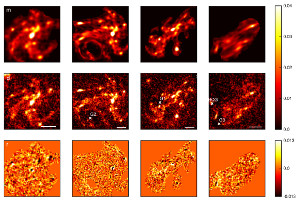|
|  |
At large scales, the cold dark matter model has been very successful in
describing the observed properties of the Universe. With the use of N-body
numerical simulations, detailed predictions have been made on the formation and
evolution of the dark matter distribution at various scales. In particular, cold
dark matter haloes are expected to be self-similar over a wide range of masses
and to have a well-defined mass density distribution.
Gravitational lensing is a powerful tool to precisely measure the total mass
distribution over a wide range of distances from the cluster centre. In
combination with other measurements it therefore allows the scientists to study
the interaction between the dark matter and the baryons in the cluster. In this
work they focused on the galaxy cluster MACS J1149.5+2223 with the aim of
providing a robust total mass model over a wide range of distances.
The galaxy cluster MACS J1149.5+2223 (located at redshift 0.544) was initially
discovered by the Massive Cluster Survey and acts as a strong gravitational lens
for at least 5 galaxies (with redshifts between 1.4 and 3.0), which are lensed
in as many as 15 different images. One of the lensed galaxies is an impressive
triply-imaged grand-design face-on spiral galaxy, which is also strongly lensed
in two distinct Einstein rings by two cluster galaxies (see figure 1).
Previous gravitational lens models of this cluster were based on the
reconstructions of a relatively limited number of image positions of the
multiply lensed bright clumps and on simple scaling relations for the lensing
contribution of the cluster member galaxies. Because of these limitations, many
details of this lens system were reproduced only approximately.
In this work, they used a more sophisticated approach instead. They modelled all
five cluster galaxies in the cluster centre that are close to multiply lensed
images by using individual mass profiles. From the lensed background galaxies,
they identified twice as many constraints as in previous models. Their advanced
lens modelling technique uses not only the information on the positions of the
multiply lensed images, but also their full surface brightness distribution.
The unique configuration of this lens system allowed them to reconstruct in
particular the surface brightness distribution of the large central spiral
galaxy in great detail. In addition, we were able to measure the mass profiles
for several other individual cluster members and to determine the overall mass
profile for the galaxy cluster as whole from its centre to a distance of up to
33 arcseconds (from 8 to 80 kpc) from the brightest cluster galaxy.
Our model indicates a large core (about 12 arcseconds) in the dark matter
distribution of the cluster and we find that the total mass profile at the very
centre is dominated by the brightest cluster galaxy. The inferred slope of the
dark matter profile of MACS J1149.5+2223 is therefore shallower than the profile
expected from pure dark matter simulations (the Navarro Frenk White (NFW)
profile). This suggests that the baryons at the cluster centre have influenced
the dark matter distribution.
Stefan Rau, Simona Vegetti and Simon White
References:
Lensing model of MACS J1149.5+2223, I. Cluster mass reconstruction
Rau S., Vegetti S., White S. D. M.
Monthly Notices of the Royal Astronomical Society 2014; 443:957-968, July 17,
2014
 paper at arxiv paper at arxiv
|


